The Oslo File (1).
My train from Fredericia dumped me at Copenhagen Airport at 3 in the morning, giving me an uncomfortable four hours before a flight took me onwards to Oslo. This was the simpler way of travelling. I could have made the journey over a longer period by train and still seen the evening game. I arrived in Oslo to find it grey, dank and damp, but fortunately my hotel was unphased by my early arrival time and found a room for me straight away. As the weather was not in the mood for improving, I did not take in much of the locality, just a little chance to appreciate that I was close to what appeared to be a small town centre, that most of the shops were closed (it being a public holiday) and that while there were plenty of restaurants around, the prices even for the simplest meal were considerable. I was also surprised to see a number of beggars. Norway is famed as a rich country with a wide reaching welfare state, but clearly there are people who the system does not support. Not surprisingly the beggars did not appear to be of Norwegian stock, Norway has some of the shortest working weeks in Europe, and also requires a large number of expatriates to fill both the most skilled and the least skilled of positions.
The Oslo portion of my trip is not part of the standard football trip. The day after my arrival, I was joined by six Cheltenham fans from Cheltenham, five Cheltenham fans from Oslo, and one from Denmark! I think naming names is in order, so from Cheltenham we had Jim Haggin, Greg Parry, Twinners, Keatsie, Blondie and the Queen, Norwegians were Andre, Andreas (Machinen), Trygve, Even (a place on Earth), and Ole,while the Danish Yes Man also goes by the name of Klaus. Like me, Klaus had to fly in from Denmark – he works in Oslo, but had made the excursion to Copenhagen to see his home town team, Esjberg winning the Danish Cup.
I had one piece of business to conclude before becoming one of the gang – Lillestrøm SK in the top division of the Norwegian League. The Top division tends to be known under its sponsors name as Tippeligaen, but would otherwise be referred to as the Premier or Elite Series, Division One (also a National and Professional Division) and Division Two (a semi-professional league of four groups, which I shall get to later). The highest division known simply by division number is Division 3, which has 12 regional sections. I did suggest to the group we could go to a game at this level on the Friday evening, but they wisely decided an evening of beer and pizza was more enticing, and sensibly persuaded me to join in.
Anyway, to Lillestrøm, which means a 10-15 ride from the centre of Oslo, the station is generally a stop on the way to and from the airport, and the train actually passes the stadium, although it is difficult to spot, clad in houses and offices and with the floodlight pylons retracted between games. Although Lillestrøm exists and a municipality outside the capital, it is effectively a dormitory town for the city, and there is very little to see other than apartment buildings. The football club is one way in which the town can demonstrate its own identity, and as I approached the ground, I was greeted by an avenue of yellow and black flags – on both town flagpoles, and also attached to the apartment buildings. Many of these commemorate a Norwegian Cup win in 2007, the last trophy won by Lillestrøm – they have been national champions on 5 occasions, but the most recent is back in 1989. The 2007 win was also their fifth cup win. The club’s high point came in the seventies and eighties when they won each trophy four times, including the double in 1977. In common generally with Norwegian teams, Lillestrøm’s record in European competition is uninspiring, of their 16 attempts, 10 have ended at the first hurdle, most embarrassingly in the 2007-8 UEFA Cup when they were beaten by FC Kaerjeng on Luxembourg. In 2000, Lillestrøm beat both Glentoran and Dynamo Moscow before losing the Spanish sides Alaves – their best run.
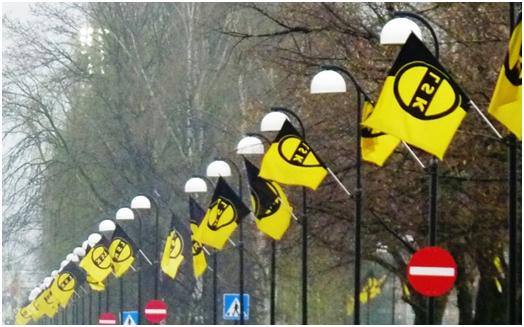
The stadium itself is hidden inside a square of office and apartment buildings – arriving by foot from town, once takes an underpass to cross the road, and then enters through a gap in the buildings with office entrances each side. The far end appears to be apartments, and a few people were watching the game from second floor balconies. If you live on the first floor, your balcony will give a wonderful view of the top rows of seating. All four sides are seated stands, with roofing and pillars that impede the views from the higher rows of seats. I was on the east side, close to the railway, while the west side had a second tier of business seats. Admission to the sides of the ground is 300 Kr, (around £33), and no programme was available
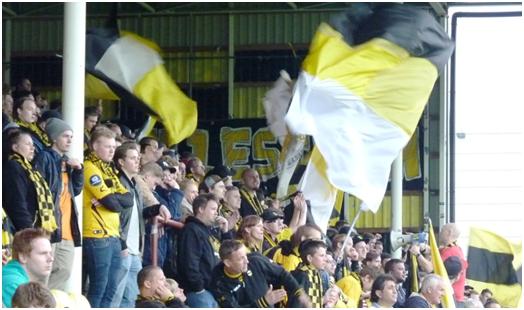
The southern end of the East Stand is the “singers section”. I noticed at the end that one person collected the flags to return to a storage cupboard on site.
The visitors were Sogndal, and both sides lined up in classic 4-4-2 formation. Lillestrøm started the brightest, bringing their Ivorian winger, Moryke Fofana into the play whenever they could. Fofana turned out to one of those players that flatters but cannot deceive, and seeing as he was effectively marked out, he was replaced at half time. Sogndal had plenty of pace, and basically tried to get the ball up as quickly as possible, and hopefully win corners or free kicks so as they could add the height of their centre halfs. This was how they went ahead in the 23rd minute, winning a corner which was crossed in from the right and met by the head of Gustav Valsvik. This sent the ball across the face of the goal, and with Lillestrøm struggling to find a way to clear it, Hannu Patronen, (the other centre half) got his foot in for 1-0. Once they were ahead, Sogndal seemed to assert an authority. A second goal was added and again it was a Valsvik header, this time all that a free kick needed to reach the target. The frustration of home fans was obvious, and another failure by Fofana just before the break caused someone not far away from me in the seats to scream (in English), “Just F***ing cross the Ball!”.
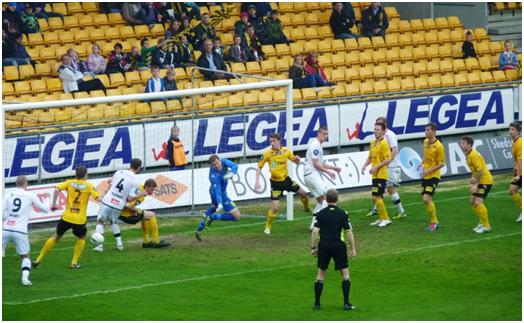
First goal – Valsvik on the right hand post has headed the ball on. How Lillestrøm allowed the ball to get from here to be in front of Patronen (4) is beyond me, but I’m guessing Østil (2) will not enjoy watching the replay.
Lillestrøm needed a change, so Fofana was taken off at half time, and it was his replacement, Ohi Omoijuanfo that scored their first goal. The real change however had been to start playing the ball down the other wing, with full back Scheel overlapping or playing ahead of his winger and playing several dangerous crosses. Lillestrøm levelled with 16 minutes to play, when Gulbrandsen managed to produce an unimpressive dive, which somehow convinced the referee. Petter Moen scoring from the spot – but Lillestrøm were never convincing winners of the point, and could not push their advantage when Patronen received his second booking and meant Sogndal played the final ten minutes with just ten men.
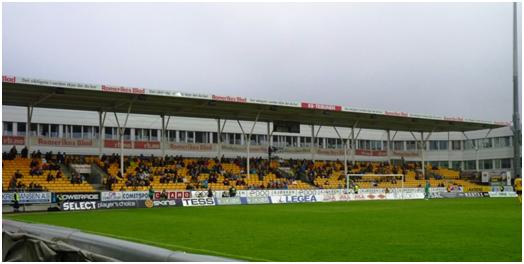
The seating behind the goal, showing the office buildings that hide the stadium.
On Friday morning, most of the roaming Cheltenham support were arriving in town, so I quietly awaited the arrival. All storms after all need a lull beforehand. When they were leaving the airport, I received a text to give time of arrival at the station, and that two of our Norwegian brethren were to be there as well. I naturally made my way to join at the meeting point. We quickly found a pub around the corner from the station, and while most were ordering standard lagers, and the queen was discovering her white wine and soda would have to be without soda, I noticed the row of bottles from a local brewery, which seemed to be a complete compendium of beer styles. I pointed out the Brunn, but one of my hosts decided instead to go to the top of the range – so I got a strong dark almost treacle like beer, with significant quantities of sediment swirling around the glass. The general price of a beer in Oslo is now around 60kr, which with an exchange rate of about 8.7, works out around £6.90 – my beer was twice that. This was the only beer I took at this strength – it was not exactly a session beer after all, and all the rest of my beers cost less than £10 each. One of the Norwegians paid for this first round with a simple swipe of his credit card, we all came to do the same with our own rounds.
All of the Norwegians we met were working, but as far as I know none had particularly high paying jobs – but still they can buy rounds of beer costing over £50 without comment. It is a country of high beer prices (indeed high prices for everything), and high taxation, but of high wages that cover this. In other words, if you use indices like the time the average man has to work to pay for a “Big Mac”, the average Norwegian is actually well placed compared to most of Europe – but the actual price of the burger is higher in Oslo.
For the moment, the continuing oil glut (even if peak production has passed) and the size of the country’s sovereign wealth fund means the exchange rates are not going to change. The question of how Norway is to transition back to the mainstream when oil revenues reduce appears to be left on the back burner.
Anyway, I had the chance to go to a match at Norwegian fourth level on Friday night, but no one else around was interested and it did not take much to persuade me I would be better heading to a Norwegian flat to drink beer and eat Pizza. The flat we went to belonged to one of the Norwegian Robins, but not one that was joining us, as he was out of town. The flat contained a most monumental sound system controlled from a PC, but not one of us could manage to turn it on, and the music ended up being supplied from a mobile phone connected to speakers found in another room. Next, we drank beer, and some scotch and ate some pizza. Meanwhile, the final member of the party, Twinners was sending text messages in the report on his progress through Heathrow. Eventually, we headed back to town to meet Twinners as he arrived, and (what a surprise), continuing drinking there. I can no longer recall where I was drinking, but my main choice now was a dark local beer supplied on draft that appears to be available in most bars in Oslo.
By the end of the evening, the Danish Yes Man was the last of the local contingent and he suggested moving on to a strip bar. Most of us declined this, and on the basis of what happens in Oslo, stay in Oslo, I will not say who actually went along (it wasn’t me), anyway, most of their friends have already heard of the 3200 Kr (over £350) for a “lesbian lap dance duo”. I was impressed that one of our men at the club had the presence of mind to insist that one of the strippers was blond. The one place in Oslo where blonds appear to be in short supply would be lap dancing clubs, as none of the dancers are likely to be locally born and bred.
Not wanting to get back to alcohol in a hurry, the second morning was spent on the open top bus tour. The bus is not truly open, as it has a canvas cover – which in turn creates a wind tunnel of the whole upper deck. The tour guide insists that Oslo is one of the world’s biggest cities, but this is done just by appropriating the surrounding mountains and trees and call them Oslo. It is a small and generally compact place, with a shortage of things for a bus tour to comment on. So we would head down a road and be told that on the right, you can see the folk museum, and then minutes later, on the left you can see the folk museum.
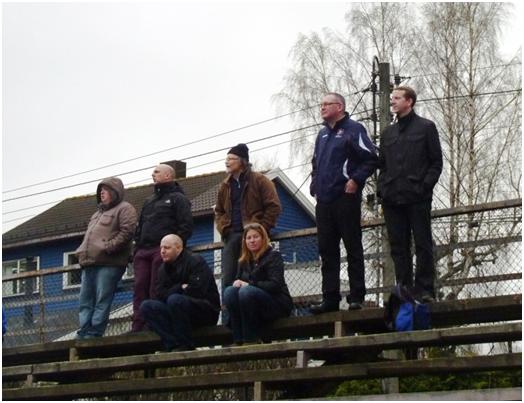
Cheltenham fans (and an interloper with a bobble hat) “enjoying” the action at Kjelsas
Then a quick drink was taken, along with a snack lunch before we all embarked on the bus to Kjelsas. I did not take lunch with the hope of finding food at the football. Norwegian football has two national, fully professional divisions, followed by semi-professional leagues with four groups in Division Two, (as the third level is called), and 12 groups in Division Three. The match I could have gone to on Friday night was in Division Three, but Kjelsas was in division two. The trip involved a 25 minute bus ride out into the suburbs, (it’s a tram route, but this was a Tram replacement bus). The stadium is a little ramshackle, with a club house selling coffee, waffles and the local non speciality of hot dog sausages in some type of pancake. Admission was 100 Kr, and attracted 156 to watch. A small programme, consisting of one piece of A4 folded over as an A5 programme was free. The far side to the entrance consisted of plentiful wooden bench seating – some with plastic seats attached, but the only cover was provided by a few awnings over a veranda to the side of the clubhouse, and frankly a little more would have been nice in the cold drizzle of the afternoon. To the sides of the pitch were piles of snow some covered by sweepings from the artificial pitch, which was showing signs of wear and poor maintenance, (as is common at this level, the pitch is a 3G artificial surface). The game itself was not up to match with two goals near the half way mark to liven things up just a little. We were impressed with the small group of visiting fans, who kept up a chant sounding like “Combien Baerum” throughout. It is a pity they only know one song. We are not certain of the word used, but we suspect it was Norwegian for “Come on”, and not French for “How Much”.
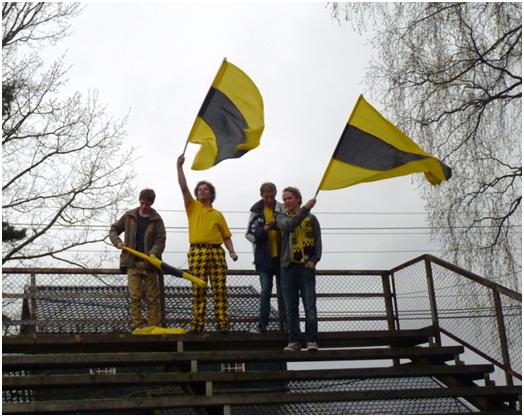
“Combien Baerum” – some fans who were impressed by the action
With the English Cup final now hidden away late into the Saturday afternoon, we missed little of the game in heading back to the town and finding our way back into the sports bar near the hotel. It was now packed out, showing an embarrassing lack of taste on behalf of many Norwegians, sporting the light blue shirts of Manchester City. Wigan shirts were not very much in vogue. The bar also held magazines including those for the association of English supporters clubs in Norway. While it was not surprising to find the biggest supported clubs were the successful Premier League clubs, Cheltenham actually have more Norwegian support than some of the Premier clubs, and indeed Reading and Southampton could not muster any support at all.
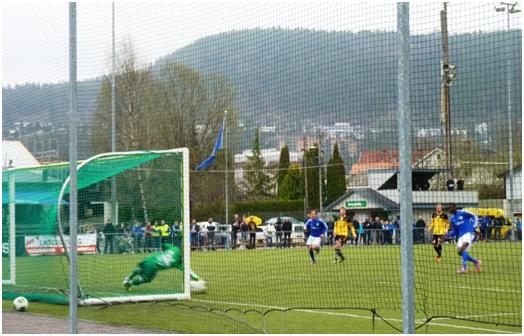
Kjelsas’ Akinbola Akinyemi (right) equalises from the penalty spot
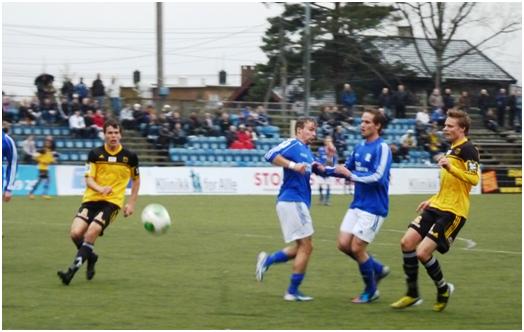
For our evening meal, we were given a choice of Reindeer or Whale, the two meats Norway is well known for. I went for the more environmentally favoured Reindeer, (Heidi said she could not eat Rudolf, but there was no sign of my meat having ever had a red nose). I did get a taste of the whale steak, and I must say it was quite delicious. Between the English and those Norwegians that had joined us again, there were 11 for dinner, and some amusement all around when we discovered a meal for 11 came to exactly 3200 Kr. Yes, in Oslo, 11 people can be fed, even on Whale steak for the cost of a couple of lap dancers!
More beer was taken after the meal, but by this point I could not say where I was, we stopped at a Karaoke bar, where Keatsie did a passable version of “My Way”, especially as this was not the song he had selected
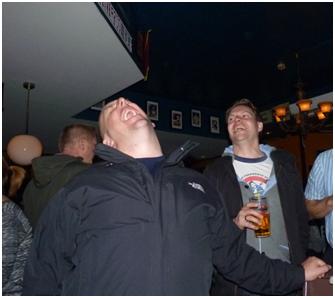
Reaction to Keatsie’s song.